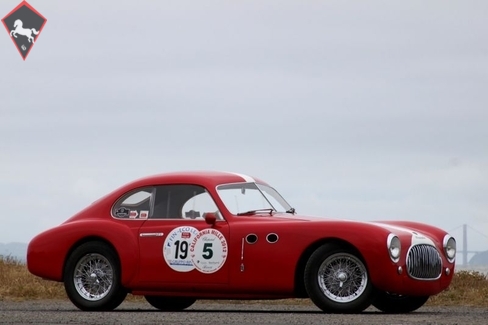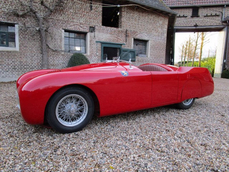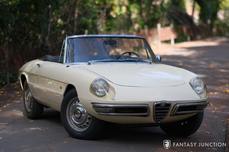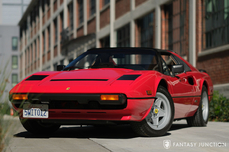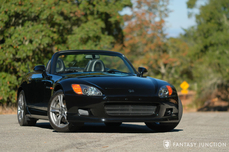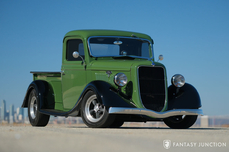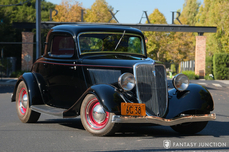Cisitalia 202 1100 c.c. 4-Cylinder no. 069 1947
Allgemeine Beschreibung :
1947 Cisitalia 202 Coupe
s/n 036, engine no. 069
Red with Tan Interior
The Cisitalia 202 is a fascinating car created by Piero Dusio’s Compagnia Industriale Sportiva Italia (which gives the name CISItalia). Dusio was previously a soccer star and set up the consortium in 1939, which was involved in sporting equipment, military uniforms (during World War II), textiles, and banking. After the war, he hired Fiat engineers Dante Giacosa and Giavonni Savonuzzi to go to work help realize a long-held dream of making his own sports and racing cars.
The firm’s first creation, the D46 was a single seater with space frame chassis and modified Fiat mechanical components, including the 4-speed gearbox (although modified to be a 3-speed pre-selector in this application) and 1100cc engine. The engine was suitably upgraded with dry sump lubrication and Zenith-Torino downdraft carburetor, which increased the output. Seven D46s made Cisitalia’s competition debut at the Coppa Brezzi and Dusio himself won the race driving one of them.
The company’s second model was the 202, a car with similar mechanicals but full bodywork on a space frame chassis, available in closed form by Pinin Farina, or in open form. Quite costly at approximately $5000 for a coupe or $7000 for a spyder, the cars were not produced in large numbers, but they achieved distinction nevertheless. For example, Cisitalias won their class and placed 2nd, 3rd, and 4th overall in the 1947 Mille Miglia, the highest placing of those cars being piloted by Tazio Nuvolari. As a result, his name came to be applied to the open variant of the 202. Additionally, the Museum of Modern Art displayed a 202 in its 1951 exhibit, which brought further visibility to the relatively obscure cars. Of the 153 coupes produced, it is believed by experts that approximately 35 survive today, making this an exceptionally rare car.
This particular example is a matching-numbers 202 with fascinating history. Built in October 1947, this car was originally registered in Trieste and then Milan by 1950, owned by Nino Borsari, an Italian champion bicyclist and Olympic gold medalist (1932). He traveled the world and was popular in Australia and the United States, and was stranded in Australia in 1939 due to the outbreak of World War II. He opened a bicycle shop in Melbourne and remained in Australia for many years and was later credited with the lobbying that allowed Melbourne to host the 1956 Olympics.
Borsari took the car to Australia with him in 1950, and raced it over the next five years, including the Rob Roy Hillclimb on 23 September 1950, the Ballarat Aerodrome, Bathurst on Easter of 1951, Strathpine in 1953, and Fisherman’s Bend in 1954. There are numerous photos of the car in competition from this period, as well as other period photos showing the car on display at a Concours. The car comes with many clippings from newspaper articles, magazines, and race programs, including a short newspaper article indicating that Borsari was fined for driving dangerously.
In 1960, the car belonged to Ian Hall, also in Australia, and then passed on to an owner in Hobart, Tasmania. Its next owner was in Melbourne, who kept it briefly until being obliged to sell it when his wife fell ill. Rino Boccalatte, also of Melbourne, became the car’s next owner in the 1960s, and kept the car for more than twenty years, where it resided along with his Giulietta Spyder, Ferrari Dino, and his wife’s black Ferrari 250 GTE. He transported the car to Italy to participate in the Mille Miglia Storico in 1988, and the car remained in Australia until 1991 or 1992, when it was sold to an American collector living in Ohio. Around this time, the car was repainted from burgundy to red, and the car participated in the Mille Miglia Storico again in 1993 and 1998.
Its next owner was in Florida, and it was purchased by its current owner, a collector in North Carolina, in 2011. The car participated in the Monterey Historics in 2010 and has had $31,000 in mechanical work since 2011, including rebuilt gearbox, brakes, new driveshaft, rebuilt carburetors, new fuel pump, new rear exhaust, new battery, valve adjustment, ignition system service, repacked front wheel bearings, radiator and fuel tank restorations, and many other jobs. He also drove the car in the 2012 California Mille.
The car is extremely well-documented and comes with copies of its Italian registration documents from Trieste and Milan, period photographs, newspaper and magazine articles from the car’s competition exploits in Australia, racing programs mentioning the car, various original brochures from Cisitalia along with a technical data sheet, correspondence, and invoices for recent service work. The car also comes with a spare transmission (needing rebuilding) and driveshaft.
Cosmetically, the car is an attractive event car with glossy paint and straight body with very nice panel fit. Close inspection reveals some flaws to the paint: the occasional surface crack, a scratch on the right front fender, and a few chips. There is some superficial bubbling on the spare tire cover, the bottom of the right door, and the left rocker panel ahead of the left rear wheel. The bright trim is very good to excellent throughout, including the wheels, and the overall presentation of the car is consistent with an attractive car suitable for events that does not need to be refinished at this time unless its next owner wishes to show it. The side windows are Plexiglas and have some scratches. The remaining glazing and lights are in very nice condition. The car sits on Pirelli Cinturato tires.
The interior presents similarly, with an older restoration that is holding up well. The vinyl upholstery is excellent and the car has dark brown carpets in very good shape. The dashboard and instruments are in very nice condition, as are the switches, controls, and brightwork. The headliner is in good shape as well. The steering wheel is very nice although the chrome finish on the metal parts is showing age. The storage area behind the front seats is surprisingly spacious, which further enhances this car’s utility for event use and touring.
The engine compartment is tidy and attractive, and reflects the extensive recent mechanical work the car has seen. Certain areas such as the front crossmember show some cosmetic aging, but the mechanical components are clean and well-serviced, with new yellow Ferrari type fuel hoses, and tidy cooling, ignition, fuel systems. The polished Cisitalia valve cover is very cool and in very good shape.
This is an exceptional opportunity to acquire a rare and desirable Cisitalia 202 with excellent history and documentation. Extremely rare cars to begin with, this example is matching-numbers and has fascinating history dating back to its early days, including period racing history. It is fantastically documented with photos, newspaper and magazine articles, correspondence, and service records, all neatly arranged in a large binder. Widely event eligible, this example has participated in some of the world’s most renowned events, including the Mille Miglia Storico, California Mille, and Monterey Historics. In short, this car is everything that a high caliber classic should be: beautiful, rare, suitable for competition or standard road use, and widely event eligible, and this example is further distinguished by its history, documentation, and matching-numbers status.
http://fantasyjunction.com/cars/1707-Cisitalia-202%20-1100%20c.c.%204-Cylinder
1947 Cisitalia 202 1100 c.c. 4-Cylinder no. 069 is listed verkauft on ClassicDigest in Emeryville by Fantasy Junction for Preis nicht verfügbar.
Fakten der Auto
Karosserietyp : Auto Marke : Cisitalia Modell : 202 Ausführung : 1100 c.c. 4-Cylinder no. 069 Hubraum : 1.1 Modelljahr : 1947 Lage : Emeryville Fahrzeug Anmeldung : Normal
Verkauft
Angaben Zum Verkäufer
Verkauft
People who viewed this Cisitalia 202 also viewed similar Cisitalia listed at ClassicDigest
Other cars listed for sale by this dealer
